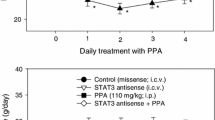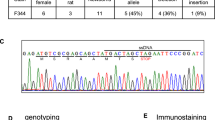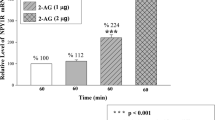Abstract
It has been reported that antioxidative enzymes, neuropeptide Y (NPY), and c-AMP response element-binding protein (CREB) are involved in regulating phenylpropanolamine (PPA)-mediated appetite suppression. Here, we investigated whether Y1 receptor (Y1R) might be involved in this regulation. Rats were daily treated with PPA for 4 days. Changes in the contents of NPY, Y1R, glutathione peroxidase (GP), and CREB were assessed and compared. Results showed that Y1R, GP, and CREB increased, with a maximal increase about 100, 200, and 150 %, respectively, on Day 2. By contrast, NPY decreased with a biggest reduction about 48 % on Day 2 and the pattern of expression during PPA treatment was opposite to those of Y1R, GP, and CREB. Central knockdown (using antisense) or inhibition (using antagonist) of Y1R expression modulated the anorectic response of PPA and the reciprocal regulation between NPY and GP (or CREB), revealing an essential role of Y1R in regulating NPY, GP, and CREB. These results suggest that Y1R participates in the reciprocal regulation of NPY, GP, and CREB in the hypothalamus during PPA treatment in conscious rats. The present results may aid the therapeutic research of PPA and related antiobesity drugs.






Similar content being viewed by others
References
Acuna-Goycolea C, van den Pol AN (2005) Peptide YY(3–36) inhibits both anorexigenic proopiomelanocortin and orexigenic neuropeptide Y neurons: implications for hypothalamic regulation of energy homeostasis. J Neurosci 25:10510–10519
Biala G, Kruk M, Budzynska B (2009) Effects of the cannabinoid receptor ligands on anxiety-related effects of d-amphetamine and nicotine in the mouse elevated plus maze test. J Physiol Pharmacol 60:113–122
Brothers SP, Wahlestedt C (2010) Therapeutic potential of neuropeptide Y (NPY) receptor ligands. EMBO Mol Med 2:429–439
Chee MJ, Mörl K, Lindner D, Merten N, Zamponi GW, Light PE, Beck-Sickinger AG, Colmers WF (2008) The third intracellular loop stabilizes the inactive state of the neuropeptide Y1 receptor. J Biol Chem 283:33337–33346
Chee MJ, Myers MG Jr, Price CJ, Colmers WF (2010) Neuropeptide Y suppresses anorexigenic output from the ventromedial nucleus of the hypothalamus. J Neurosci 30:3380–3390
Cheng JT, Kuo DY (2003) Both a1-adrenergic and D1-dopaminergic neurotransmissions are involved in phenylpropanolaminemediated feeding suppression in mice. Neurosci Lett 347:136–138
Cohen H, Liu T, Kozlovsky N, Kaplan Z, Zohar J, Mathé AA (2012) The neuropeptide Y (NPY)-ergic system is associated with behavioral resilience to stress exposure in an animal model of post-traumatic stress disorder. Neuropsychopharmacology 37:350–363
Deo GS, Dandekar MP, Upadhya MA, Kokare DM, Subhedar NK (2010) Neuropeptide Y Y1 receptors in the central nucleus of amygdala mediate the anxiolytic-like effect of allopregnanolone in mice: behavioral and immunocytochemical evidences. Brain Res 1318:77–86
Eva C, Serra M, Mele P, Panzica G, Oberto A (2006) Physiology and gene regulation of the brain NPY Y1 receptor. Front Neuroendocrinol 27:308–339
Gerald C, Walker MW, Criscione L, Gustafson EL, Batzl-Hartmann C, Smith KE et al (1996) A receptor subtype involved in neuropeptide-Y-induced food intake. Nature 382:168–171
Goodhue A, Bartel RL, Smith NB (2000) Exacerbation of psychosis by phenylpropanolamine. Am J Psychiatry 157:1021–1022
Heilig M (1995) Antisense inhibition of neuropeptide Y (NPY)-Y1 receptor expression blocks the anxiolytic-like action of NPY in amygdala and paradoxically increases feeding. Regul Pept 59:201–205
Heilig M, Thorsell A (2002) Brain neuropeptide Y (NPY) in stress and alcohol dependence. Rev Neurosci 13:85–94
Higuchi H, Niki T, Shiiya T (2008) Feeding behavior and gene expression of appetite-related neuropeptides in mice lacking for neuropeptide Y Y5 receptor subclass. World J Gastroenterol 14:6312–6317
Horvath TL, Andrews ZB, Diano S (2009) Fuel utilization by hypothalamic neurons: roles for ROS. Trends Endocrinol Metab 20:78–87
Hsieh YS, Yang SF, Chiou HL, Kuo DY (2007a) Roles of central catecholamine and hypothalamic neuropeptide Y genome in the development of tolerance to phenylpropanolamine-mediated appetite suppression. Behav Neurosci 121:933–940
Hsieh YS, Yang SF, Kuo DY (2007b) Intracerebral administration of protein kinase A (PKA) or c-AMP response element binding protein (CREB) antisense oligonucleotide can modulate amphetamine-mediated appetite suppression in free-moving rats. Am J Physiol Endocrinol Metab 292:123–131
Hsieh YS, Yang SF, Chu SC, Kuo DY (2008a) Interrupting activator protein-1 signaling in conscious rats can modify neuropeptide Y gene expression and feeding behavior of phenylpropanolamine. J Neurochem 104:50–61
Hsieh YS, Yang SF, Chu SC, Ho YJ, Kuo CS, Kuo DY (2008b) Transcriptional interruption of cAMP response element binding protein modulates superoxide dismutase and neuropeptide Y-mediated feeding behavior in freely moving rats. J Neurochem 105:1438–1449
Hsieh YS, Yang SF, Chen PN, Chu SC, Chen CH, Kuo DY (2011) Knocking down the transcript of protein kinase C-lambda modulates hypothalamic glutathione peroxidase, melanocortin receptor and neuropeptide Y gene expression in amphetamine-treated rats. J Psychopharm 25:982–994
Jaillard T, Roger M, Galinier A, Guillou P, Benani A, Leloup C et al (2009) Hypothalamic reactive oxygen species are required for insulin-induced food intake inhibition: an NADPH oxidasedependent mechanism. Diabetes 58:1544–1549
Kuo DY, Yang SF, Chu SC, Chen CH, Hsieh YS (2009) Roles of protein kinase C-α isozyme in the regulation of oxidative stress and neuropeptide Y gene expression in phenylpropanolamine-mediated appetite suppression. J Neurochem 108:1495–1506
Kuo DY, Yang SF, Chu SC, Chen CH, Chen PN, Hsieh YS (2010) The effect of protein kinase C-delta knockdown on anti-free radical enzyme and neuropeptide Y gene expression in phenylpropanolamine-treated rats. J Neurochem 114:1217–1230
Kuo DY, Chen PN, Yang SF, Chu SC, Chen CH, Kuo MS, Yu CH, Hsieh YS (2011) Role of reactive oxygen species-related enzymes in neuropeptide Y and proopiomelanocortin-mediated appetite control: a study using atypical protein kinase C knockdown. Antioxid Redox Signal 15:2147–2159
Kuo DY, Chen PN, Chu SC, Hsieh YS (2012a) Knocking down the transcript of NF-kappaB modulates the reciprocal regulation of endogenous antioxidants and feeding behavior in phenylpropanolamine-treated rats. Arch Toxicol 86:453–463
Kuo DY, Chen PN, Yu CH, Kuo MH, Hsieh YS, Chu SC (2012b) Involvement of neuropeptide Y Y1 receptor in the regulation of amphetamine-mediated appetite suppression. Neuropharmacology 63:842–850
Kushi A, Sasai H, Koizumi H, Takeda N, Yokoyama M, Nakamura M (1998) Obesity and mild hyperinsulinemia found in neuropeptide Y-Y1 receptor deficient mice. Proc Natl Acad Sci USA 95:15659–15664
Larsen PJ, Jessop DS, Chowdrey HS, Lightman SL, Mikkelsen JD (1994) Chronic administration of glucocorticoids directly upregulates prepro-neuropeptide Y and Y1-receptor mRNA levels in the arcuate nucleus of the rat. J Neuroendocrinol 6:153–159
MacNeil DJ (2007) NPY Y1 and Y5 receptor selective antagonists as anti-obesity drugs. Curr Top Med Chem 7:1721–1733
Mashiko S, Moriya R, Ishihara A, Gomori A, Matsushita H, Egashira S, Iwaasa H, Takahashi T, Haga Y, Fukami T, Kanatani A (2009) Synergistic interaction between neuropeptide Y1 and Y5 receptor pathways in regulation of energy homeostasis. Eur J Pharmacol 615:113–117
Mercer RE, Chee MJ, Colmers WF (2011) The role of NPY in hypothalamic mediated food intake. Front Neuroendocrinol 32:398–415 (review)
Michel MC, Beck-Sickinger A, Cox HXVI et al (1998) International Union of Pharmacology recommendations for the nomenclature of neuropeptide Y, peptide YY, and pancreatic polypeptide receptors. Pharmacol Rev 50:143–150
Nguyen AD, Herzog H, Sainsbury A (2011) Neuropeptide Y and peptide YY: important regulators of energy metabolism. Curr Opin Endocrinol Diabetes Obes 18:56–60
Ogawa S, Pfaff DW (1998) Current status of antisense DNA methods in behavioral studies. Chem Senses 23:249–255
O’Shea D, Morgan DG, Meeran K, Edwards CM, Turton MD, Choi SJ (1997) Neuropeptide Y induced feeding in the rat is mediated by a novel receptor. Endocrinology 138:196–202
Pandey SC (2003) Anxiety and alcohol abuse disorders: a common role for CREB and its target, the neuropeptide Y gene. Trends Pharmacol Sci 24:456–460
Paxinos G, Watson C (1986) The rat brain in stereotaxic coordinates, 2nd edn. Academic Press, Sydney
Penzner JH, Thompson DL, Arth C, Fowler JK, Ary AW, Szumlinski KK (2008) Protracted ‘anti-addictive’ effects of adolescent phenylpropanolamine exposure in C57BL/6J mice. Addict Biol 13:310–325
Peterson KL, Lee JA, Hovda LR (2011) Phenylpropanolamine toxicosis in dogs: 170 cases (2004–2009). J Am Vet Med Assoc 239:1463–1469
Pilsczek FH, Karcic AA, Freeman I (2003) Case report: dexatrim (phenylpropanolamine) as a cause of myocardial infarction. Heart Lung 32:100–104
Ritter RC, Slusser PG, Stone S (1981) Glucoreceptors controlling feeding and blood glucose: location in the hindbrain. Science 213:451–452
Rudolf K, Eberlein W, Engel W, Wieland HA, Willim KD, Entzeroth M et al (1994) The first highly potent and selective non-peptide neuropeptide Y Y1 receptor antagonist: BIBP 3226. Eur J Pharmacol 271:R11–R13
Sato N, Ogino Y, Mashiko S, Ando M (2009) Modulation of neuropeptide Y receptors for the treatment of obesity. Expert Opin Ther Pat 19:1401–1415
Schöbitz B, Pezeshki G, Probst JC, Reul JM, Skutella T, Stöhr T, Holsboer F, Spanagel R (1997) Centrally administered oligodeoxynucleotides in rats: occurrence of non-specific effects. Eur J Pharmacol 331:97–107
Seif-El-Nasr M, Atia AS (2008) Effect of MAO-B inhibition against ischemia-induced oxidative stress in the rat brain. Comparison with a rational antioxidant. Arzneimittelforschung 58:160–167
Sheriff S, Dayal R, Kasckow J, Regmi A, Chance W, Fischer J, Balasubramaniam A (1998) NPY upregulates genes containing cyclic AMP response element in human neuroblastoma cell lines bearing Y1 and Y2 receptors: involvement of CREB. Regul Pept 75–76:309–318
Szumlinski KK, Liu A, Penzner JH, Lominac KD (2007) Protracted ‘pro-addictive’ phenotype produced in mice by preadolescent phenylpropanolamine. Neuropsychopharmacology 32:1760–1773
Toll K, Graf P (2006) Phenylpropanolamine’s decongestive effect on the nasalmucosa of pregnant women with nasal stuffiness. Rhinology 44:274–277
Tsakiris P, de la Rosette JJ, Michel MC, Oelke M (2008) Pharmacologic treatment of male stress urinary incontinence: systematic review of the literature and levels of evidence. Eur Urol 53:53–59
Weng G, Feinstein D, Reis D, Wahlestedt C (1996) Neuropeptide Y receptor gene regulation in mouse adrenocortical Y-1 cells. Regul Pept 63:53–56
Widnell KL, Self DW, Lane SB, Russell DS, Vaidya V, Miserendino MJD et al (1996) Regulation of CREB expression: in vivo evidence for a functional role in morphine action in the nucleus accumbens. J Pharmacol Exp Ther 276:306–315
Winders SE, Amos JC, Wilson MR, Rushing PA, Dykstra T, Coday MC (1994) Effects of chronic phenylpropanolamine infusion and termination of body weight, food consumption and water consumption in rats. Psychopharmacology 114:513–519
Wynne K, Stanley S, McGowan B, Bloom S (2005) Appetite control. J Endocrinol 184:291–318
Yulyaningsih E, Zhang L, Herzog H, Sainsbury A (2011) NPY receptors as potential targets for anti-obesity drug development. Br J Pharmacol 163:1170–1202
Zhang M, Creese I (1993) Antisense oligodeoxynucleotide reduces brain dopamine D2 receptors: behavioral correlates. Neurosci Lett 161:223–226
Zhang LL, Wang JJ, Liu Y, Lu XB, Kuang Y, Wan YH, Chen Y, Yan HM, Fei J, Wang ZG (2011) GPR26-deficient mice display increased anxiety- and depression-like behaviors accompanied by reduced phosphorylated cyclic AMP responsive element-binding protein level in central amygdala. Neuroscience 196:203–214
Acknowledgments
This study was supported by a grant from the National Science Council (NSC-101-2320-B-040-002-MY3) and a grant from the Chung Shan Medical University (CSMU 101-OM-A-133).
Conflict of interest
The authors declare that they have no conflict of interest.
Author information
Authors and Affiliations
Corresponding author
Rights and permissions
About this article
Cite this article
Hsieh, YS., Chen, PN., Kuo, MH. et al. Neuropeptide Y Y1 receptor knockdown can modify glutathione peroxidase and c-AMP response element-binding protein in phenylpropanolamine-treated rats. Arch Toxicol 87, 469–479 (2013). https://doi.org/10.1007/s00204-012-0947-7
Received:
Accepted:
Published:
Issue Date:
DOI: https://doi.org/10.1007/s00204-012-0947-7




